For as long as people have been dreaming and building, the construction industry has also been fraught with peril for anyone unlucky enough to be caught in the wrong place at the wrong time. From collapsing cranes and scaffolds to uncapped oil wells to chemical exposures, being safe onsite means employing vigilance, preparation and foresight.
Not every disaster happens quickly. In fact, some take years to fully manifest. And while a few are famous and recent, others may have faded from memory. One way or another, their impact on us, and the construction industry, will never go away.
Willow Island, West Virginia
One of the worst construction accidents in U.S. history took place at Willow Island, West Virginia in 1978. While dozens worked on a cooling tower, the scaffolding they stood on suddenly collapsed, causing 51 workers to fall to their deaths. Subsequent OSHA investigations proved that a series of errors, short cuts and accidents was responsible for the scaffolding’s collapse. In their haste to finish the project, contractors attached the scaffold to concrete that hadn’t had time to cure. Bolts were missing and the existing bolts were of poor quality. Only one access ladder was available, restricting the worker’s ability to escape. And an elaborate concrete hoisting system was modified without proper engineering review. As a result of this wholly preventable accident, a renewed emphasis was placed on safety within the nuclear construction industry, unfortunately too late for the men working that day.
East 51st Street, New York City
In 2008, during the construction of a 40-story apartment building on East 51st Street in NYC, a crane collapsed as workers were attaching a steel collar in an effort to raise a tower crane higher. Seven people were killed when the crane snapped and came crashing to the earth. The accident was one of the worst in modern New York history, and construction on the building has been halted ever since. A subsequent investigation showed there had been numerous safety violations cited for the construction site and contractor leading up to the accident, but they were seen as routine before the crane collapsed.
Hawk’s Nest Tunnel, West Virginia
As mentioned, the damage from some accidents can take years to be felt. The Hawk’s Nest Tunnel is a prime example of this. Construction on the tunnel began in 1927 to help generate power for a local plant downstream. But during its construction, a mineral used for creating glass products called silica was discovered, prompting the owners to ask workers to mine it. Unfortunately, almost none of the workers received proper breathing equipment while working, and they inhaled large amounts of dust. Within a few years, many became ill with silicosis, a deadly lung disease that attacks the lungs. Some experts estimate that over 1,000 workers died as a result of this exposure, while others place the number at a more conservative 476. This tragedy brought recognition of acute silicosis as occupational lung disease and as a result, compensation legislation was passed to protect workers.
Deepwater Horizon, Gulf of Mexico
Of course, no discussion of construction disasters would be complete without mentioning the April 20, 2010 oil spill in the Gulf of Mexico. On that day, the Deepwater Horizon oil platform exploded and sank, killing 11 workers, spewing millions of barrels of oil into the Gulf of Mexico for over 87 days before its broken wellhead was finally capped. It is considered to be one of, if not the worst, industrial environmental disasters in U.S. history. Investigations pointed to insufficient safety systems and defective cement in the walls of the deep-sea well which led to its catastrophic blowout. The long-term health consequences of the spill on human and marine life are unknown, but its negative effect on the environment of the gulf has been widespread, to be sure.
An Ounce of Prevention
There is no way to predict or prevent every accident ahead of time, of course. But if these incidents teach us anything, it’s that often, overlooking small details is what leads to catastrophic events. Not following standard practices and procedures, cutting corners and failing to consider warning signs is a sure path to failure. So what can you do prevent or mitigate problems on the job, and most importantly, keep your people safe?
Certainly, following construction best practices to the letter is highly important. And making sure your employees are trained well for their responsibilities and versed in all aspects of safety will make a huge difference in avoiding accidents. But your contingency planning should also include being covered by excellent insurance. While it may sound obvious to protect yourself financially, the questions your insurer asks you when formulating your policy could alert you to issues you might not have considered. And often, their time spent on your site or while in the planning stage could be what makes the difference between your project going smoothly or going wrong.
So pay attention to every detail, don’t rush and make sure you’ve covered every angle, including your coverage. Find an agent now because when it comes to construction and safety, an ounce or two of prevention can be priceless.


